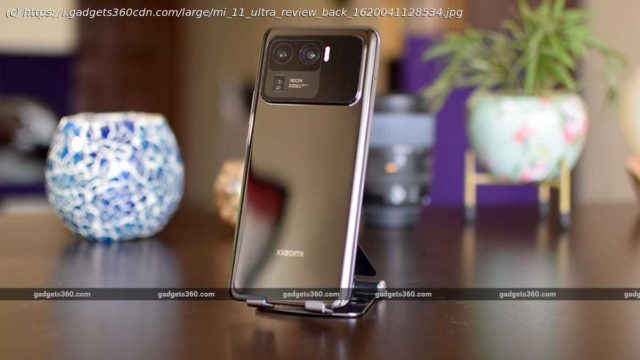The Mi 11 Ultra is Xiaomi’s best effort at creating a premium flagship in 2021, and on paper, it seems to check all the boxes and then some. Priced quite aggressively at Rs. 69,999, can it rival more expensive offerings from Samsung and Apple? Read our review to find out.
Around this time last year, Xiaomi began testing the waters of the ultra-premium smartphone segment with the Mi 10 5G. It was a solid offering that got most things right, however it was quickly overshadowed by the OnePlus 8 Pro. Xiaomi went on to launch more affordable models in the same series, the latest one being the Mi 10i, which has reportedly done wonders for the company. Xiaomi continues to have great success in the budget and mainstream segments, but this year, it’s aiming to disrupt the flagship segment too. The recently launched Mi 11 series boasts of impressive features at prices that are often well below those of the competition. We’ve already seen the great value offered by the Mi 11X, and now it’s time to take a closer look at the Mi 11 Ultra. On paper, this smartphone exceeds expectations for a flagship priced at Rs.69,999, but there’s still a brand perception hurdle that Xiaomi needs to overcome. When you have flagships such as the OnePlus 9 Pro, iPhone 12 mini, and Samsung Galaxy S21 all selling at the same price as the Mi 11 Ultra, does it make sense to go with the newcomer? Xiaomi has launched the Mi 11 Ultra in just one configuration in India, with 12GB of LPDDR5 RAM and 256GB of UFS 3.1 storage, and it is priced at Rs.69,999. This is Xiaomi’s most expensive smartphone in India yet, and the price might be a lot to digest for many given the ‘value’ perception that the brand has created for itself over the years. The Mi 11 Ultra is based on the Mi 10 Ultra, a similarly equipped flagship from last year which didn’t launch in India. Xiaomi is taking an even bigger gamble with the Mi 11 Ultra than it did with the Mi 10 5G, but will it pay off? The design of the Mi 11 Ultra is stunning. We’ll get to the massive camera hump in a bit, but leaving that aside, it’s as premium as phones get these days. It has an aluminium frame, a curved display with Corning Gorilla Glass Victus, and a ceramic back. The glass on the front is actually curved on all four sides, which is a unique design choice. The benefit of this is that gestures performed from the bottom of the screen are smoother as your finger doesn’t hit any sharp edges. In fact, the metal frame, front, and back blend into one another perfectly so you don’t really feel any edges at all when handling the phone. All these premium materials contribute to the 234g weight of the Mi 11 Ultra. It’s very heavy, but thankfully it’s not very thick at 8.38mm. Most of the weight is concentrated at the top making one-handed use a bit challenging. The rectangular camera module looks a lot like the Poco M3’s camera bump, just thicker. The main reason for this awkward bulge is the massive main camera sensor in the phone, which we’ll get to later. The Mi 11 Ultra’s camera bump is massive, which could be a turn-off for some A side benefit of this is that the Mi 11 Ultra is stable when using it on its back on a flat surface. You can even use the bottom of the camera module as support for your finger when using this phone one-handed. Fingerprints are a big problem on the Ceramic Black variant, but you can also get the Mi 11 Ultra in white, which should hide them better. On the right side of the camera module is a 1.1-inch (126×294 pixel resolution) OLED display. This mini touchscreen automatically lights up when you place the Mi 11 Ultra face down on any surface. It can be customised to show the battery level, notifications, date and time, a custom message, or an image. You can also use it to answer or reject an incoming call. Most importantly, you can use it as a viewfinder for taking a selfie with either of the three rear cameras. It’s largely a gimmicky addition, and looks like it was added mainly to fill the empty space at the back. I also didn’t like the fact that the menu system for customising this display is buried in the Settings app and not easy to get to. Coming to the main display on the front, the Mi 11 Ultra uses a 6.81-inch QHD+ (3200×1440) AMOLED panel with a 120Hz variable refresh rate, a 480Hz touch sampling rate, and support for popular HDR formats such as HDR10+ and Dolby Vision. Xiaomi says it has used Samsung’s latest E4 AMOLED panel type, which on the Mi 11 Ultra, can achieve an impressive peak brightness of 1,700 nits. You get an in-display fingerprint sensor but it isn’t the quickest or the most consistent one I’ve used. What’s more intuitive is face recognition on the Mi 11 Ultra, which is lightning quick and works even when the phone is upside down. The display on the Mi 11 Ultra is big and imposing with excellent brightness and colours The power and volume buttons on the Mi 11 Ultra have good tactile feedback and are placed well. At the bottom, there is a dual-SIM tray, a USB Type-C port, and one of the speakers. The earpiece doubles up as a second speaker for stereo sound. Xiaomi has also thrown in an infrared emitter on the top for controlling IR gadgets and appliances. I didn’t receive my review unit in a retail box, but this phone should come with a Type-C to 3.5mm headphone adapter, USB cable, case, and fast charger. The Mi 11 Ultra typically comes with a 67W charger, but due to certification constraints at the time of launch, the Indian units will have a 55W charger in the box. The Mi 11 Ultra uses Qualcomm’s current top-end Snapdragon 888 5G SoC. One thing worth pointing out is that the Mi 11 Ultra supports a total of 13 5G bands, unlike other phones that have launched with the same SoC such as the OnePlus 9 Pro, which only supports two. This should ensure maximum compatibility when 5G eventually does launch in India, or if you happen to travel to another country. The phone also supports NFC, Wi-Fi 6e, and Bluetooth 5.2. The Mi 11 Ultra boasts of many other creature comforts that you’d typically find in a premium flagship. The stereo speakers are tuned by Harman Kardon, there’s an IP68 rating for dust and water resistance, Hi-Res Audio support for both wired and wireless headphones, and a linear haptic motor for more precise vibration feedback. It has a 5,000mAh battery with support for 67W wired and wireless charging. You will need to purchase a special wireless charger from Xiaomi to achieve this speed. This phone can also reverse wireless charge other devices at up to 10W.






